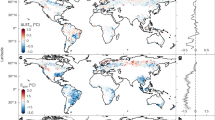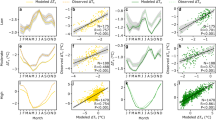Abstract
Carbon uptake by forestation is one method proposed1 to reduce net carbon dioxide emissions to the atmosphere and so limit the radiative forcing of climate change2. But the overall impact of forestation on climate will also depend on other effects associated with the creation of new forests. In particular, the albedo of a forested landscape is generally lower than that of cultivated land, especially when snow is lying3,4,5,6,7,8,9, and decreasing albedo exerts a positive radiative forcing on climate. Here I simulate the radiative forcings associated with changes in surface albedo as a result of forestation in temperate and boreal forest areas, and translate these forcings into equivalent changes in local carbon stock for comparison with estimated carbon sequestration potentials10,11,12. I suggest that in many boreal forest areas, the positive forcing induced by decreases in albedo can offset the negative forcing that is expected from carbon sequestration. Some high-latitude forestation activities may therefore increase climate change, rather than mitigating it as intended.
This is a preview of subscription content, access via your institution
Access options
Subscribe to this journal
Receive 51 print issues and online access
$199.00 per year
only $3.90 per issue
Buy this article
- Purchase on Springer Link
- Instant access to full article PDF
Prices may be subject to local taxes which are calculated during checkout


Similar content being viewed by others
References
UNFCCC Kyoto Protocol to the United Nations Framework Convention on Climate Change Art. 3.3 (UNEP/INC/98/2, Information Unit for Conventions, UNEP, Geneva, 1998) <http://www.unfccc.int/resource/docs/convkp/kpeng.pdf>.
UNFCCC United Nations Framework Convention on Climate Change Art. 2 (UNEP/IUC/99/2, Information Unit for Conventions, UNEP, Geneva, 1999); <http://www.unfccc.int/resource/convkp.html>.
Robinson, D. A. & Kukla, G. Albedo of a dissipating snow cover. J. Climatol. Appl. Meteorol. 23, 1626–1634 (1984).
Harding, R. J. & Pomeroy, J. W. The energy balance of the winter boreal landscape. J. Clim. 9, 2778– 2787 (1996).
Sharratt, B. S. Radiative exchange, near-surface temperature and soil water of forest and cropland in interior Alaska. Agric. Forest Meteorol. 89, 269–280 (1998).
Thomas, G. & Rowntree, P. R. The boreal forests and climate. Q. J. R. Meteorol. Soc. 118, 469– 497 (1992).
Bonan, G. B., Pollard, D. & Thompson, S. L. Effects of boreal forest vegetation on global climate. Nature 359, 716–718 (1992).
Bonan, G. B., Chapin, F. S. & Thompson, S. L. Boreal forest and tundra ecosystems as components of the climate system. Clim. Change 29, 145–167 (1995).
Douville, H. & Royer, J. F. Influence of the temperate and boreal forests on the Northern Hemisphere climate in the Météo-France climate model. Clim. Dyn. 13, 57– 74 (1997).
Nabuurs, G. J. & Mohren, G. M. J. Modelling analysis of potential carbon sequestration in selected forest types. Can. J. Forest Res. 25, 1157–1172 (1995).
Nilsson, S. & Schopfhauser, W. The carbon sequestration potential of a global reforestation program. Clim. Change 30, 267–293 (1995).
Watson, R. T. et al. (eds) Land Use, Land-use Change and Forestry (Cambridge Univ. Press, Cambridge, 2000).
Schimel, D. et al. in Climate Change 1995. The Science of Climate Change Ch. 2 (eds Houghton, J. T. et al.) 65–131 (Cambridge Univ. Press, Cambridge, 1995).
Edwards, J. M. & Slingo, A. Studies with a flexible new radiation code. I: Choosing a configuration for a large-scale model. Q. J. R. Meteorol. Soc. 122, 689– 720 (1996).
Pope, V. D., Gallani, M. L., Rowntree, P. R. & Stratton, R. A. The impact of new physical parametrizations in the Hadley Centre climate model - HadAM3. Clim. Dyn. 16, 123– 146 (2000).
Hansen, J. E. et al. Efficient three dimensional global models for climate studies, Models I and II. Mon. Weath. Rev. 111, 609 –662 (1983).
Wilson, M. F. & Henderson-Sellers, A. A global archive of land cover and soils data for use in general circulation climate models. J. Climatol. 5, 119–143 (1985).
Woodward, F. I., Smith, T. M. & Emanuel, W. R. A global land primary productivity and phytogeography model. Glob. Biogeochem. Cycles 9, 471– 490 (1995).
Myhre, G., Highwood, E. J., Shine, K. P. & Stordal, F. New estimates of radiative forcing due to well mixed greenhouse gases. Geophys. Res. Lett. 25, 2715–2718 (1998).
Keeling, C. D. & Whorf, T. P. Atmospheric CO 2 Concentrations - Mauna Loa Observatory, Hawaii, 1958-1997 (NDP-001, Carbon Dioxide Information Analysis Centre, Oak Ridge, Tennessee, 1998).
Willmott, C. J., Rowe, C. M. & Mintz, Y. Climatology of the terrestrial seasonal water cycle. J. Climatol. 5, 589–606 (1985).
Cao, M. & Woodward, F. I. Dynamic responses of terrestrial ecosystem carbon cycling to global climate change. Nature 393, 249–252 (1998).
Essery, R. Seasonal snow cover and climate change in the Hadley Centre GCM. Ann. Glaciol. 25, 362–366 (1997).
Betts, R. A., Cox, P. M., Lee, S. E. & Woodward, F. I. Contrasting physiological and structural vegetation feedbacks in climate change simulations. Nature 387, 796–799 (1997).
Levis, S., Foley, J. A. & Pollard, D. Potential high-latitude vegetation feedbacks on CO 2-induced climate change. Geophys. Res. Lett. 26, 747–750 (1999).
Kondratyev, K. Y., Korzov, V. I., Mukhenberg, V. V. & Dyachenko, L. N. in Land Surface Processes in Atmospheric General Circulation Models (ed. Eagleson, P. S.) 463–514 (Cambridge Univ. Press, Cambridge, 1982).
Gedney, N. & Valdes, P. J. The effect of Amazonian deforestation on the northern hemisphere circulation and climate. Geophys. Res. Lett. 27, 3053–3056 ( 2000).
Cox, P. M., Betts, R. A., Jones, C. D., Spall, S. A. & Totterdell, I. J. Acceleration of global warming due to carbon-cycle feedbacks in a coupled climate model. Nature 408, 184–187 ( 2000).
Cox, P. M. et al. The impact of new land surface physics on the GCM simulation of climate and climate sensitivity. Clim. Dyn. 15, 183–203 (1999).
Posey, J. W. & Clapp, P. F. Global distribution of normal surface albedo. Geofis. Int. 4, 333– 348 (1964).
Acknowledgements
I thank S.E. Lee and F.I. Woodward for providing data from the Sheffield University vegetation model, and P.M. Cox, J.M. Edwards, R.L.H. Essery, W.J. Ingram, G.J. Jenkins, J.E. Lovelock, S. Nilsson, I.C. Prentice, P.R. Rowntree, K.P. Shine, P.J. Valdes and D.A. Warrilow for advice, comments and discussion. This work forms part of the Climate Prediction Programme of the UK Department of the Environment, Transport and the Regions.
Author information
Authors and Affiliations
Corresponding author
Rights and permissions
About this article
Cite this article
Betts, R. Offset of the potential carbon sink from boreal forestation by decreases in surface albedo. Nature 408, 187–190 (2000). https://doi.org/10.1038/35041545
Received:
Accepted:
Issue Date:
DOI: https://doi.org/10.1038/35041545
This article is cited by
-
Changes in albedo and its radiative forcing of grasslands in East Asia drylands
Ecological Processes (2024)
-
Accounting for albedo change to identify climate-positive tree cover restoration
Nature Communications (2024)
-
Emphasizing the land use-cloud-radiation feedback in detecting climate effects of land use and land cover changes
Climate Dynamics (2024)
-
Seasonal and long-term dynamics in forest microclimate effects: global pattern and mechanism
npj Climate and Atmospheric Science (2023)
-
Large variations in afforestation-related climate cooling and warming effects across short distances
Communications Earth & Environment (2023)
Comments
By submitting a comment you agree to abide by our Terms and Community Guidelines. If you find something abusive or that does not comply with our terms or guidelines please flag it as inappropriate.



